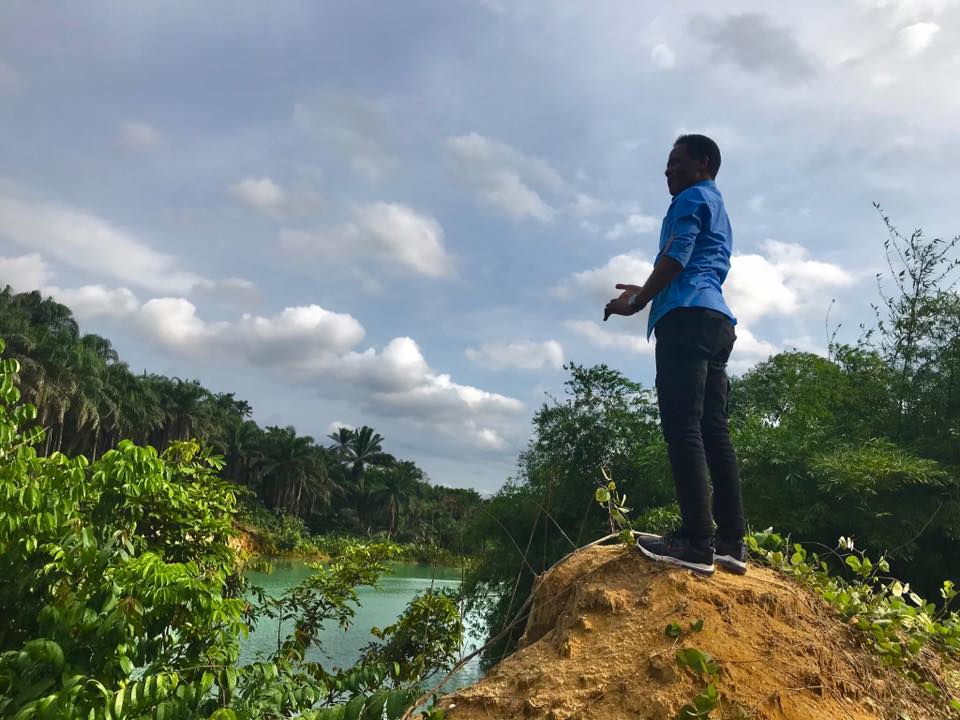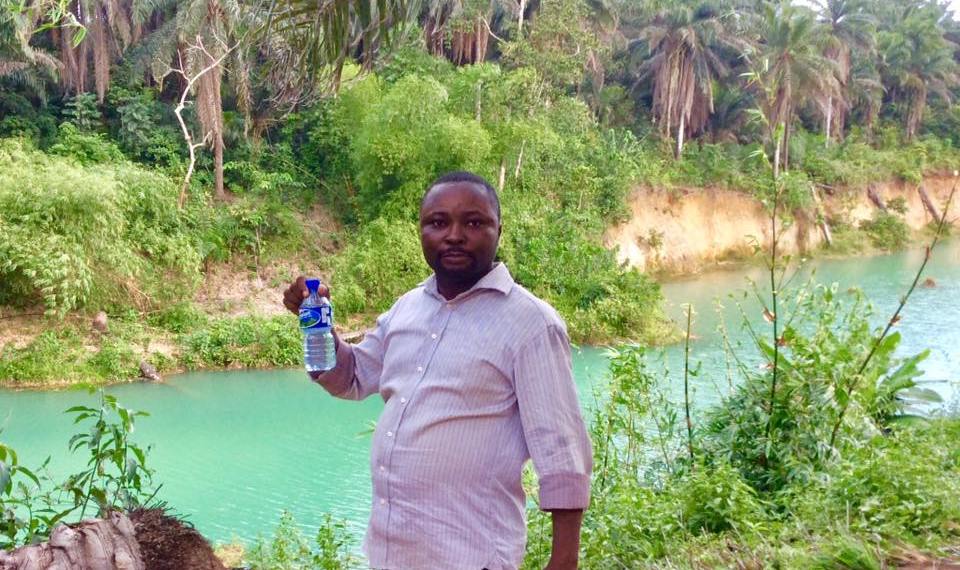On the outskirts of Ikot Akpa in Ibesikpo, Akwa Ibom State, lies a river that has left locals and visitors alike both amazed and mystified—a river whose jade-green hue seems almost otherworldly. My long-awaited visit to this unique waterway was finally set, but it nearly derailed before it even started.
My companion for this adventure was Thomas Thomas, a resourceful local journalist not unlike the famed explorer Mungo Park, except his journeys revolve around contemporary discoveries in Nigeria. Thomas had uncovered the existence of this “Green River” just a week prior, but finding him on the scheduled day proved no small feat. Monday, April 26, 2021, was tightly packed for Thomas as he juggled assignments, a reality familiar to many aspiring journalists striving to make ends meet. Still, my determination saw us both winding toward a destination that would offer more questions than answers.
We followed a sandy incline surrounded by silent bush, the sky heavy with impending rain. With only my explorer’s basic gear, I checked the weather: 28°C, humidity a sticky 89%, with steady winds at 15 kilometers per hour. The air was thick, and the village’s tranquility felt untouched by the bustle of Nigeria’s cities. Each step toward the river came with anticipation—the kind that makes your heart beat a little faster.
As I soaked in the ambiance, marveling at the untouched nature, Thomas gave me a nudge that snapped me from my thoughts. “Oga, look. That’s the green river.”

What greeted my eyes was nothing short of astonishing. I stood frozen, a mix of fear and awe rendering me speechless. My jaw dropped at the surreal vision—a river radiantly green, slicing through the landscape like a ribbon of gemstone. For a moment, I instinctively shielded my face as if to block the scene from overwhelming me. My voice finally returned: “Park, park, park,” I directed my driver, Abednego.
The car halted abruptly, but Abednego shared my sense of stupefied alarm. He had never encountered a green river either. We both needed time to recover from the shock, though he was the more reluctant traveler, hesitating to descend the slope with Thomas and me. The green water was too uncanny for comfort. “Oga, I’ve never seen anything like this in my life,” Abednego managed, shaking his head in disbelief.
Eventually, with caution and encouragement, he agreed to drive down to the riverbank. Before us, the water glided silently from left to right, or perhaps east to west—it was impossible to say exactly, lost as we were in the sheer magic of the sight.
![The green river in Akwa Ibom State, Nigeria's South-south [PHOTO CREDIT: Anietie Usen]](https://nowahalazone.com/wp-content/uploads/2025/10/The-green-river-in-Akwa-Ibom-State-Nigerias-South-south-1.jpg)
We soon found the courage to approach; the air thick with reverence, every step closer heightened the sense of stepping into a fable. Posing for photos by the water’s edge, we noticed three villagers about 100 meters away. Choosing not to intrude at first, Thomas and I trekked downstream—at least two kilometers—through sand white as chalk and air cool like dew. The lush vegetation of bamboo and fronds pressed in as we wandered.
“Imagine it, Thomas,” I exclaimed. “White sand underfoot, a green river beside us, and the wind like gentle rain on the skin.” The moment felt poetic, as if the river itself demanded such reflection. Our progress was halted by thick bamboo, an impassable wall barring the way. I lamented the absence of canoes and paddlers—a missed economic opportunity for local youths, as Thomas promptly noted. “Once people start coming here, the boys no go lack at all,” he said, gesturing at the idle canoe pulled halfway onto the bank.
With few options, we circled back and caught up with the villagers, eager for any tales or explanations they might share. Among them was Edidiong Archibong, a lifelong resident who claimed, “I was born to see the river this way.”
When we asked if he would guide us to the river’s source, Archibong declined. He explained that the origins lie in a rocky outcrop now hidden amidst thick, evergreen bamboo. “These days, nobody goes there anymore,” said another villager, pointing upstream. They explained, too, that the river’s colour fluctuates with the seasons. According to Archibong, “The water in dry, sunny weather is much greener. During rainy season like now, rainwater washes soil down into the river, dulling the colour.” This insight offered a subtle explanation for the changes we witnessed.
One question nagged at me—would the water remain green if scooped into a bottle? The locals insisted it turned white in containers. Thomas, ever the skeptic, volunteered to conduct the experiment despite concerns over the river’s depth. “If you throw that tall palm tree in, the river will swallow it whole,” warned one observer.
Carefully, Thomas approached and managed to fill a plastic bottle with the river’s water. “It’s white!” he called out, holding the bottle aloft for us to see. We gathered beneath a bamboo tree, taking comfort on a bench crafted from local timber, snacking and reflecting on the day’s discoveries.
So what causes this riverside magic—green to the eye, white in a bottle?
![Thomas Thomas holds out a container to show that water from the river turns white when put inside a bottle [PHOTO CREDIT: Anietie Usen]](https://nowahalazone.com/wp-content/uploads/2025/10/Thomas-Thomas-holds-out-a-container-to-show-that-water-from-the-river-turns-white-when-put-inside-a-bottle-1-1.jpg)
Local theory credits the effect to reflection. One villager suggested, “The river mirrors the green palm fronds.” It’s a common sight in Akwa Ibom for waterways to be fringed with lush vegetation, but none exhibit such vibrant green hues. The possibility of algae was discussed and dismissed—the locals were adamant: “No be algae,” asserted one elder. Scientific input is lacking for now, but hydrologists and government agencies may soon turn their attention to this natural wonder for proper analysis.
Whether the explanation is optical, chemical, or even spiritual—some attributing it to the handiwork of God—the river is already sparking curiosity. The Green River is now on the radar for would-be tourists, researchers, and environmentalists alike. Its existence raises intriguing environmental and ecological questions about water quality, natural filtration, and the impact of seasonal rains on Nigeria’s waterways. The fascination draws comparisons to similar natural mysteries around Africa, such as Ghana’s Boti Falls and Cameroon’s blue lakes. Yet, the river in Ikot Akpa remains singular in its legend and allure.
The journey to Akwa Ibom’s green river reminds us that even in the most familiar locales, untold natural wonders can still surprise and inspire. As local communities contemplate the tourism potential and environmental importance of sites like these, the rest of Nigeria and West Africa may yet discover more about their shared landscapes and untapped heritage.
What makes the Green River so captivating, and how might it shape the local economy, science, or environmental initiatives in the future? Could similar wonders exist in your state or country, just waiting to be explored? Drop your thoughts or stories in the comments, and stay with us as we bring you the most fascinating stories and discoveries from across Nigeria, West Africa, and beyond.
Reach out and get your story featured or discuss story sales at story@nowahalazone.com. For general support, email support@nowahalazone.com.
Keep the conversation going with your observations or local legends in the comments below.
Follow us for more updates, discoveries, and engaging stories on
Facebook,
X (Twitter), and
Instagram.










